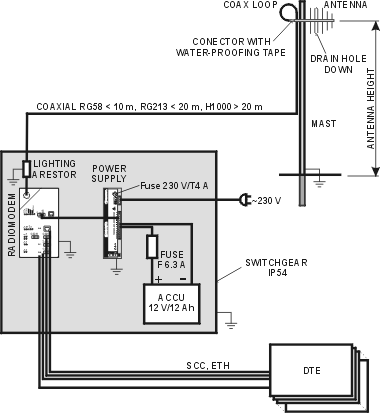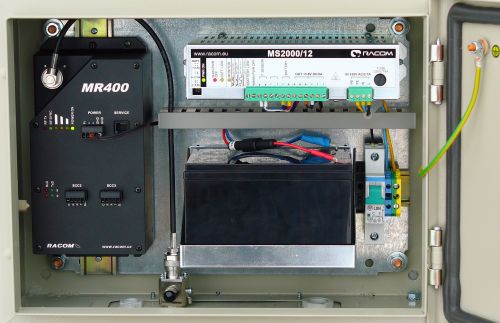Racom routers are built into a robust metal case and are suitable for applications which place them in various environments from air-conditioned offices to heavy industry factories. To a certain extent the method of installation needs to be adapted to this. All information in this chapter describes the standard method of installation for normal industrial applications, which has been derived from valid regulations for such equipment and also from the long-term experience of our engineers. In the case of larger-scale networks and more complicated applications we recommend that users order a project assessment from Racom, or a partner company, which should consist of careful measurements of the strength and quality of a signal and an assessment of the conditions for the propagation of radio waves.
Each radio equipment must comply with operating conditions for the given frequency band in the country in which it is operated and the person running the equipment is responsible for this.
For reliable operation of routers it is important to ensure that all equipment, for which data is transmitted through the router, is connected correctly. Also ensure the antenna is correctly connected and installed, a suitable and safe supply of electricity is provided, equipment is mounted correctly, and that all corresponds to the given operating conditions, without a negative influence on the specific properties of our equipment. A description and wiring of individual connectors and interfaces is described in the connectors chapter.
Optimum installation of the antenna is influenced by a number of factors. The topology of the radio network, the separation of radio points, the terrain profile between them, and conditions for signal propagation all influence the type of antenna to be used and where it should be located. Sometimes the appearance of the structure on which the antenna is to be located and the possibility of its damage in publicly accessible places should also be taken into consideration. Generally it can be said that for point-to-point type connections directional antennas are used, and for more remote points and points with a poorer signal multilink directional antennas with greater gain are used. The height of the antenna above ground level may improve the quality of the signal. The standard height of approx. 5 m can be increased severalfold, but always in consideration of the length of the antenna lead, because each coaxial cable used has its own defined attenuation. For longer leads coaxial cables with lower attenuation are used and generally these have a larger cross-section, worse mechanical properties and are more expensive. When using external antennas we recommend protecting the radio modem with overvoltage protection on the coaxial cable.
We recommend to use vertical polarization for all radio modem networks.
Racom radio equipment in typical installations comply with applicable standards for human exposure to RF electromagnetic fields, namely with standard EN 50385: 2002. The minimal safe distance is ensured by the antenna position on a mast. When special installation is required, the conditions of the standard above have to be met. The distance between the persons and antenna minimal 5 m comply with applicable standards for human exposure of general public to RF electromagnetic fields, namely with standard EN 50385: 2002. It is valid for all power levels and all antenna types which firm Racom provides.
A power supply meeting the specified parameters (see the table of technical parameters) needs to be used for supplying radio routers. We recommend using an MS2000 power supply or other power supply of MORSE system , which has been developed specially for these purposes, and where necessary is capable of switching to a back-up battery, as well as monitoring its state of charge, and also charging.
The Data Terminal Equipment, a programmable controller, a PC or any other device communicating over the radio network, has to be connected to the router by a data cable to the serial or the Ethernet interface according to the respective standard. These interfaces are described in detail in the chapter Connectors.
Radio routers can be mounted either to a mounting plate using screws or by mounting on a DIN rail. See the table of technical parameters for the dimensions and spacing separation of mounted parts. Generally for industrial applications the radio routers are mounted together with the overvoltage protection, power supply, and back-up battery into a switchboard with IP54 protection.

